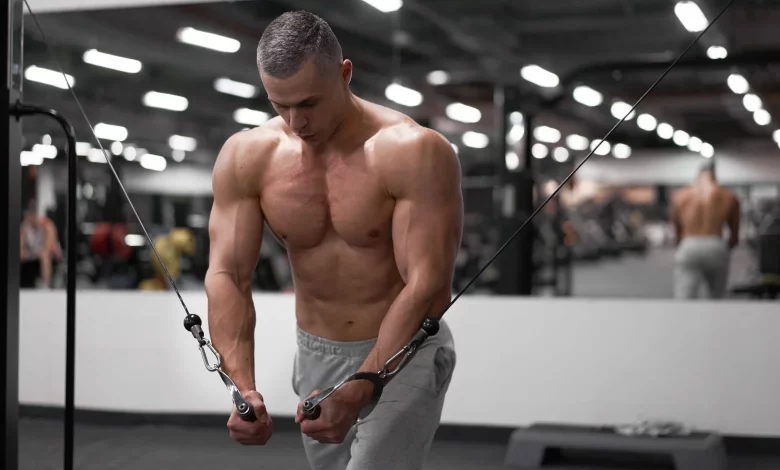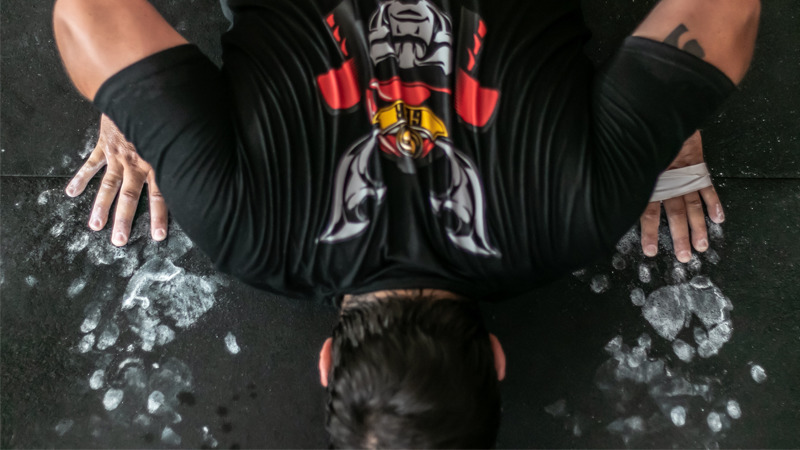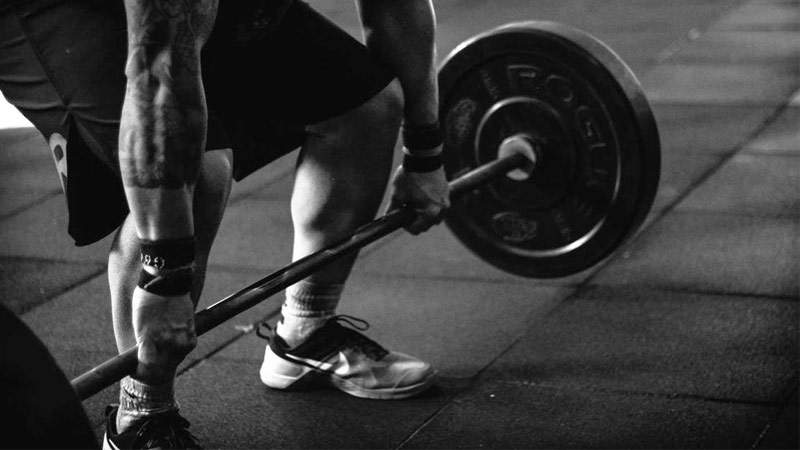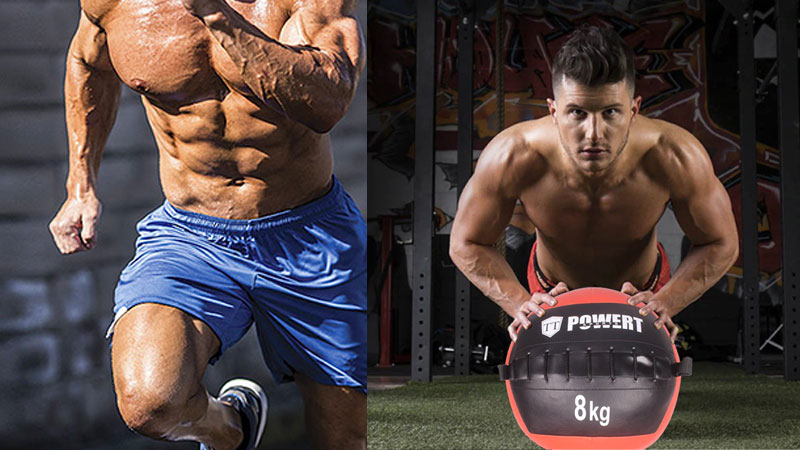
When it comes to building a strong and defined chest, many people focus on exercises that also engage the shoulders. However, for those who want to isolate and target the chest muscles specifically, there are a variety of exercises that can be performed without engaging the shoulders.
These exercises can help to increase chest strength and size while minimizing the risk of injury or strain to the shoulder joints. This is particularly important for people recovering from a shoulder issue, or who are prone to them in general. Shoulder health is a consistent issue for gym goers with the shoulder joint being the most likely cite of issues for men in general.
Both poor posture, poor form tend to play a large part in this, meaning that inadvertantly overtraining the shoulder is common. This can lead to man experiencing shoulder pain, rotator cuff tears or other injuries to shoulder muscles.
In this article, we will explore some of the best chest exercises that don’t engage the shoulders, and how to perform them correctly for optimal results and avoid shoulder injury through overtraining.
The importance of targeting the chest without involving the shoulders
The chest is one of the largest muscle groups in the body, and it is often a focus in strength training and bodybuilding. However, it is important to target the chest without involving the shoulders to avoid injury and maximize results.
When performing chest exercises, it is common for the shoulders to become involved. This can lead to shoulder strain or injury, as well as take away from the effectiveness of the chest workout. By targeting the chest muscles specifically, you can ensure that you are getting the most out of your workout and reducing the risk of injury.
One way to target the chest without involving the shoulders is to focus on exercises that isolate the chest muscles. These include exercises such as the chest press, chest fly, and cable crossover. These exercises allow you to really focus on the chest muscles and avoid the involvement of the shoulders.
Another important factor in targeting the chest without involving the shoulders is proper form. It is important to maintain proper posture and alignment throughout your workout to avoid putting unnecessary strain on your shoulders. This may involve adjusting the angle of your bench or adjusting the weight you are using.
In addition to reducing the risk of injury, targeting the chest without involving the shoulders can also lead to better results. By isolating the chest muscles, you can ensure that they are getting the full benefit of the workout and are being fully engaged. This can lead to increased strength, muscle growth, and definition in the chest muscles.
Top 5 home chest exercises that don’t engage the shoulders
Chest exercises are an effective way to build a strong and well-defined chest. However, some exercises may also engage the shoulders, which can cause discomfort or lead to injury. To help you avoid this, we have compiled a list of the top 5 chest exercises that don’t engage the shoulders.
1. Dumbbell Flys: This exercise targets the chest muscles without involving the shoulders. To perform this exercise, lie on a bench with a dumbbell in each hand. Extend your arms straight up with the palms facing each other. Slowly lower the weights to the sides, keeping the arms straight, until you feel a stretch in your chest muscles. Then, raise the weights back up to the starting position. This is also great to help strengthen shoulder stabilizing muscles.
2. Decline Dumbbell Press: This exercise is great for targeting the lower chest muscles and doesn’t engage the shoulders. Lie on a decline bench with a dumbbell in each hand. Hold the dumbbells with your palms facing each other and bring them down towards your chest. Slowly push the weights back up to the starting position. You should focus on making sure your shoulder blades stay in the correct position, a good way to envisage this is to imagine trying to pinch a coin between them.
3. Incline Dumbbell Press: This exercise targets the upper chest muscles and doesn’t engage the shoulders. Lie on an incline bench with a dumbbell in each hand. Hold the dumbbells with your palms facing each other and bring them down towards your chest. Slowly push the weights back up to the starting position.
4. Cable Crossovers: This exercise is great for targeting the chest muscles and doesn’t engage the shoulders. Stand in the middle of a cable machine with the handles at shoulder height. Grab the handles and slowly bring them together in front of your chest, keeping your arms straight. Then, slowly release them back to the starting position.
5. Push-Ups: This classic exercise targets the chest muscles and doesn’t engage the shoulders much if done correctly. Start in a plank position with your hands shoulder-width apart. Lower your body down towards the ground, keeping your elbows close to your sides. Push your body back up to the starting position.
5 Best Chest Exercises For Bad Shoulders At The Gym
Though not everyone’s preference there are certainly benefits to going to the gym, and one of those is the many machines and equipment that they have. By using a machine, individuals can more easily maintain proper form and technique throughout the exercise, ensuring that the emphasis remains on the chest muscles. This controlled movement reduces the risk of compensatory movements or excessive shoulder strain, making it an excellent option for individuals with shoulder limitations or injuries. There’s also the plates and cables you can use in unique ways for a wide range of isolating exercises.
1. Machine Chest Press: Maximal Chest Engagement
The machine chest press is an exercise that effectively targets the chest muscles while minimizing shoulder involvement. Unlike exercises such as the bench press, which rely on free weights and require significant shoulder stability and coordination, the chest press machine provides a controlled movement that isolates the pectoral muscles.
- Svend Press: Engaging the chest in a unique way
The Svend Press is a unique exercise that specifically targets the chest muscles while minimizing shoulder involvement. It involves pressing a weight plate directly outwards from your chest, typically performed by holding the plate with both hands and extending the arms forward.
- Cable Flys: Expansive range of motion
Cable flys are an effective exercise for targeting the chest muscles while providing an expansive range of motion. This exercise involves using cable machines, where you stand in the middle and hold the handles or stirrups attached to the cables. By performing a fly motion, you bring the handles or stirrups together in front of your body, engaging your chest muscles.
- Plate Squeezes: An effective isolation technique
Plate squeezes are a highly effective isolation technique for targeting the chest muscles while minimizing shoulder engagement. This exercise involves pressing a weight plate directly out from your chest, similar to the Svend press. However, plate squeezes add an extra squeezing motion that intensifies the workout for your chest muscles. To perform plate squeezes, you hold a weight plate with both hands against your chest, and then you press it forward while simultaneously squeezing the plate together. This squeezing motion engages the chest muscles even more, as it activates the inner fibers of the pectoral muscles, creating an additional challenge for the chest muscles.
- Pec Deck Machine: Unparalleled chest isolation
The Pec Deck machine is a valuable and often overlooked tool for achieving unparalleled chest isolation. This machine is specifically designed to target the pectoral muscles with controlled and consistent movement, providing a focused and intense workout for the chest. The squeezing motion emphasizes the contraction of the pectoral muscles, allowing individuals to effectively isolate and engage these muscles without relying heavily on the shoulders.
How to modify traditional chest exercises for a shoulder-free workout
If you have shoulder pain or an injury, it can be challenging to perform traditional chest exercises that require pushing or pressing motions. However, you can still tone your chest muscles with modifications to these exercises that focus on the chest without involving the shoulders.
1. Bench Press with a Narrow Grip
Instead of the traditional bench press with a wide grip, try a narrow grip bench press. This exercise targets the middle of your chest and triceps while minimizing the involvement of your shoulders. Lie on a bench with your feet flat on the floor and your hands shoulder-width apart. Lower the bar to your chest and press it back up. Repeat for several sets and reps. You should feel this chest exercise a bit more in you triceps muscles and once again you’ll want to try and pinch your shoulder blades together.
2. Push-Ups with a Wide Base
Push-ups are an excellent bodyweight exercise for your chest, but they can put a strain on your shoulders. To modify this exercise, try widening your base of support by placing your hands wider than shoulder-width apart. This modification shifts the focus to your chest, reducing the load on your shoulders and improving overall shoulder health, whilst still strengthening stabilizing muscles.
3. Incline Bench Press
The incline bench press targets the upper portion of your chest. It also reduces the strain on your shoulders since it requires less pressing motion. Lie on an incline bench with your feet flat on the floor and your hands shoulder-width apart. Lower the bar to your chest and press it back up. Repeat for several sets and reps.
4. Cable Crossover
The cable crossover is an excellent exercise for targeting your chest muscles. This exercise involves pulling cables across your body, which places minimal strain on your shoulders. Stand in the center of the cable machine, holding the handles in each hand, with your feet shoulder-width apart. Pull the cables across your chest, squeezing your chest muscles. Repeat for several sets and reps.
Conclusion:
With these modifications to traditional chest exercises, you can work out your chest muscles without putting a strain on your shoulders. Remember to start with light weights and gradually increase the load as you feel comfortable. If you experience any pain or discomfort, stop the exercise and seek medical advice.
The benefits of incorporating shoulder-free chest exercises into your routine
When it comes to building a strong chest, there are a variety of exercises that can be incorporated into your routine. One type of exercise that is often overlooked is shoulder-free chest exercises. These exercises focus solely on the chest muscles, without involving the shoulders, and can provide a range of benefits.
1. Increased Muscle Activation
Shoulder-free chest exercises can increase muscle activation in the chest muscles. By removing the shoulders from the equation, the chest muscles are forced to work harder to complete the movement. This increased activation can lead to greater muscle growth and strength gains over time.
2. Reduced Risk of Injury
Incorporating shoulder-free chest exercises into your routine can also help to reduce the risk of injury. Many common chest exercises, such as the bench press, can put a lot of strain on the shoulders. By focusing solely on the chest muscles, you can reduce the load on the shoulders and decrease the risk of injury.
3. Improved Symmetry
Shoulder-free chest exercises can also help to improve symmetry in the chest muscles. When performing exercises that involve the shoulders, it is easy for one side of the chest to become more dominant than the other. By focusing solely on the chest muscles, you can ensure that both sides are being worked equally, leading to a more symmetrical chest.
4. Variety in Your Routine
Incorporating shoulder-free chest exercises into your routine can also provide variety. By mixing up your exercises, you can challenge your muscles in new ways and prevent plateaus in your progress. Additionally, shoulder-free chest exercises can be a great option for individuals who may have shoulder injuries or limitations.
Common mistakes to avoid when performing chest exercises without engaging the shoulders
When it comes to performing chest exercises, it is important to focus on engaging the chest muscles and avoiding the involvement of the shoulders. This can help prevent injury and ensure that you are targeting the right muscle groups. However, there are some common mistakes that people make when performing chest exercises without engaging their shoulders. Here are a few to watch out for:
1. Flaring the elbows: When performing exercises such as the bench press or push-ups, it can be tempting to flare your elbows out to the sides. However, this can put undue stress on your shoulders and take the focus away from your chest. Instead, keep your elbows tucked in close to your body to better engage your chest muscles.
2. Lifting too heavy: Another mistake that people make is lifting weights that are too heavy, which can cause them to use their shoulders to help lift the weight. Instead, start with a weight that you can comfortably lift for several reps while maintaining proper form.
3. Neglecting proper form: Proper form is crucial when it comes to performing chest exercises without engaging your shoulders. Make sure that you are keeping your shoulders down and back, your chest lifted, and your core engaged throughout each exercise.
4. Focusing on speed over control: Many people make the mistake of trying to perform chest exercises quickly, rather than focusing on slow, controlled movements. This can cause you to use momentum and engage your shoulders, rather than properly working your chest muscles.
By avoiding these common mistakes and focusing on proper form and control, you can perform chest exercises without engaging your shoulders and target your chest muscles more effectively.
How to progress your shoulder-free chest workout
When it comes to working out your chest, there are many exercises you can do without using your shoulders. These exercises not only help to tone and strengthen your chest muscles, but they also promote good posture and can reduce the risk of injury. Here are some tips on how to progress your shoulder-free chest workout:
1. Start with the Basics: Before you begin any advanced exercises, make sure you have a good foundation. Basic exercises like push-ups, chest presses, and flyes are great for building strength and endurance in your chest muscles. They also serve as a good warm-up for more challenging exercises.
2. Increase the Resistance: As you become more comfortable with basic exercises, it’s important to increase the resistance. This can be done by using heavier weights, resistance bands, or adjusting the incline of your bench. Increasing the resistance helps to challenge your muscles and promote growth.
3. Change Up Your Routine: Doing the same exercises over and over can lead to a plateau in your progress. To avoid this, try changing up your routine. Incorporate different exercises or variations of exercises to keep your muscles guessing. This can also help to target different areas of your chest muscles.
4. Focus on the Eccentric Phase: The eccentric phase of an exercise is when you lower the weight or resistance. This phase is often overlooked, but it’s crucial for building muscle. Try slowing down the eccentric phase of your exercises to really feel the burn in your chest muscles.
5. Add Plyometrics: Plyometric exercises involve explosive movements that can help to increase power and speed. Adding plyometrics to your chest workout can help to improve your overall athleticism. Examples of plyometric exercises for the chest include clap push-ups and medicine ball chest passes.
By following these tips, you can progress your shoulder-free chest workout and achieve a stronger, more defined chest. Remember to always listen to your body and adjust your workout accordingly.
Conclusion – Optimizing your chest workouts without straining the shoulders.
In conclusion, shoulder-free chest exercises offer an effective and safe alternative for individuals looking to build a strong and well-defined chest while minimizing strain on the shoulders. These exercises not only target the pectoral muscles but also engage various stabilizer muscles, enhancing overall upper body strength and stability.
By avoiding traditional shoulder-dependent exercises, individuals with shoulder injuries or limitations can still engage in a challenging chest workout without compromising their recovery or risking further damage. Moreover, shoulder-free chest exercises provide an opportunity for those seeking to diversify their training routine and introduce new stimuli to their muscles.
It is essential to remember that proper form and technique are crucial when performing these exercises to maximize their benefits and prevent injury. Consulting with a qualified fitness professional or physical therapist can help ensure correct execution and provide personalized guidance based on individual needs and goals.
Incorporating shoulder-free chest exercises into a well-rounded fitness program can lead to a balanced and aesthetically pleasing physique while promoting functional strength and reducing the risk of imbalances. By expanding our exercise repertoire and exploring alternative movements, we can continue to challenge ourselves, overcome limitations, and achieve our fitness objectives.






